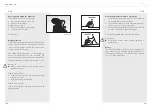
EN6
EN7
Inspired by life
Safety instructions
EN7
n
When transporting the wheelchair, always make
sure you are seated in a fixed seat of the motor
vehicle.
Attention:
n
Only lift the wheelchair using fixed parts of the
frame; do not use the removable accessories such
as armrests, footrests,
etc.
Slopes and other obstacles
(see also page 17 for more information)
Attention:
n
The risk of the wheelchair tipping over on a slope
is greater than on a flat surface.
n
Always reverse backwards down a step so that the
wheelchair cannot tip forward and let you fall.
n
Never ride the wheelchair on stairs by yourself.
n
Never ride on a slope with an angle of more than
5 degrees.
n
Ask for help from bystanders when you are not sure
that you can reach the highest point by yourself.
n
The attendant pushing the wheelchair must
continue to push the wheelchair to prevent it
running away.
n
Do not turn around on a steep slope. If the
wheelchair is at the diagonal on a steep slope, it
will significantly increase the risk of tipping.
n
When going down a slope, always keep your
speed under control.
n
The assistant must brake the wheelchair using the
push bars.
n
When moving the wheelchair by yourself, only
use your hands on the handrims to brake and do
not use the tyre brake. Otherwise, you risk losing
control of the wheelchair.
Steps
Slope
Safety instructions
EN6
Sitting in the wheelchair
Warning:
n
Make sure the fingers and limbs of the person in
the wheelchair do not get trapped. Always be very
careful:
- When the occupant is sitting lopsided in the
wheelchair.
- When the occupant’s arms hang limply over the
armrest.
- When both of the above occur.
n
An incorrect sitting posture can cause points
of pressure. If you are uncertain about this then
immediately contact your doctor or therapist.
Driving the wheelchair
Attention:
n
When driving up a slope, the centre of gravity will
shift and the wheelchair can tip backwards more
easily.
n
Pay attention to your hands when using the
handrims if there is not much room at the side(s)
of the wheelchair.
n
Assistants must never leave the wheelchair on a
slope without applying the brakes.
n
Never tackle obstacles higher than 10 cm on
your own. Only practised wheelchair riders that
have sufficient strength are usually able to tackle
obstacles higher than 10 cm.
n
Set the brake on the wheelchair before getting
into or out of the wheelchair.
n
Only use the brake to lock the wheels when
standing still. The brake is not suitable for braking
the wheelchair.
Transporting the wheelchair
Extremely dangerous:
n
The wheelchair is not Crash Test Safe, which means
it is not suitable transportation in a taxi when the
wheelchair is carrying an occupant.































